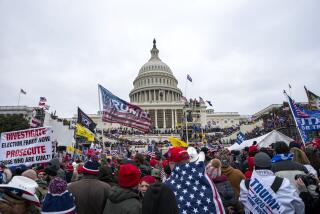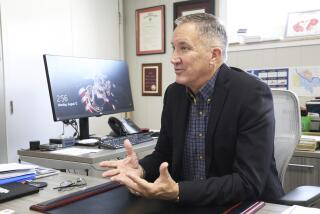Oklahoma Chaos Painted as Taint on Local Judges : Bombing: In dramatic retelling of April 19 blast, defendants’ lawyers claim fair trial would be impossible.
OKLAHOMA CITY — Arguing that no Oklahoma City judge can possibly give their client a fair trial, attorneys for Timothy J. McVeigh on Tuesday graphically recreated the pandemonium on the morning of April 19 when the federal office building here exploded and “a tidal wave of trauma rolled over” the nearby courthouse.
In court papers urging that all eight federal judges here be recused from the case, the lawyers described the horror that descended on the courthouse just across Fourth Street in downtown Oklahoma City:
More than 100 windows shattered and fell into the court building. Doors jammed. Ceiling tiles tumbled down. Bookcases were knocked off walls, sending heavy law books smashing across the floor.
Out into the streets ran terror-stricken courthouse employees--some injured, some to learn later that they had lost relatives and friends in the April 19 bombing of the Alfred P. Murrah Federal Building.
“The shock wave of the explosion blew into and through the courthouse,” said McVeigh’s attorney Stephen Jones. “The building trembled as if in an earthquake. . . . A tidal wave of trauma roll[ed] over the United States Courthouse.”
To Jones and Michael Tigar, the attorney for co-defendant Terry L. Nichols, the issue is central to their defense and shows the full-tilt strategy that they are pursuing to get to higher ground in the face of the government’s massive circumstantial case.
The attorneys are attacking everything--the suitability of the judges, the venue for the trial, the plan to try both defendants together, the death penalty the government is expected to seek, the motives of the witnesses and virtually all other aspects of the process--to focus attention away from their clients.
But unlike other famous cases, Jones and Tigar are not--at least not yet--challenging the mountain of publicity about the bombing as the reason for moving the trial.
*
Prosecutors, led by U.S. Atty. Patrick Ryan, maintain that the trial can be conducted here. They argue that the “courthouse family” is not biased against the defendants and that a fair and impassioned jury of men and women can be empaneled to render justice over McVeigh and Nichols.
“He believes that a fair trial can be held in Oklahoma City,” Ryan’s spokesman, assistant U.S. Atty. Steve Mullins, said Tuesday. “But he also believes that the trial should at a minimum be in the state of Oklahoma.
“He believes there should be access to the trial by the people that were victimized by the crime. Federal law gives them the right to be present and participate in some portions of the case.”
Furthermore, U.S. District Judge Wayne E. Alley, assigned earlier this month to hear the case, has ordered both sides to begin preparing for pretrial scheduling and other matters as though he expects the trial to take place in his courtroom downtown.
He has even taken the unusual step of filing his own declaration with the court clerk, stating that he intends “to conduct a trial in a fair, objective and dignified manner in full realization that the rights of all parties should be scrupulously observed.”
The judge also said that he lost no family or friends in the bombing and that no one on his staff lost any family members. And, he added, “none of my personal property was destroyed or damaged except for minor nicks to two or three items.”
But Jones, in his motion asking Alley to recuse himself and the other Oklahoma City federal judges, contended that Alley had downplayed the damage. By questioning Alley’s credibility, Jones increases pressure on the judge to consider taking himself out of the case. Jones, at the very least, raises an issue that could be appealed to higher courts.
Noting that Alley’s third-floor chambers line the north side of the courthouse and directly face the Murrah building, Jones said that area was “the most heavily damaged.”
“The windows were shattered, light fixtures were hanging down and glass fragments were scattered over much of the furniture,” Jones said.
“Ceiling tiles were broken and laying everywhere. Some bookcases and walls were damaged.”
He added that “courtrooms on the third floor were extensively damaged” and that “Judge Alley’s courtroom was the worst.”
“The glass skylights in the courtroom shattered, covering the floor with approximately an inch of glass,” Jones said. “The hinges on the courtroom doors were damaged, causing the doors to jam. The woodwork and the furniture, including the judge’s bench, were damaged by flying glass.”
Furthermore, he said, all of the courthouse employees were so grievously affected that none of them should be involved either.
Seconds after the blast, he said, “terror and panic” struck the employees as they madly fought their way out of the building.
“Courthouse personnel and members of the public thronged toward the ground floor exits,” he said. “Corridors became clogged with panic-stricken people just as they also began to fill with the acrid smoke and dust from the explosion.
“The exits, heavily damaged, created bottlenecks of people in shock, anger and disbelief.”
*
The defense lawyer said that many court employees are still undergoing federally assisted counseling sessions. He said that a memorial wreath was on display in the clerk’s office, next to where the court file against McVeigh and Nichols is stored.
And, he said, several court clerk employees have been “actively involved during working hours” selling T-shirts to benefit the bombing victims.
One shirt, he said, has a black-ribboned emblem of the Bureau of Alcohol, Tobacco and Firearms on the front, with the words: “In Memory, April 19, 1995.” The shirt also carries an additional message: “A society that makes war against its police had better learn to make friends with its criminals.”
A second T-shirt has the symbol of the U.S. attorney’s office and the words “May Justice Prevail,” according to Jones.
Another example of possible federal judicial bias here, Jones said, was U.S. District Judge Fred Daugherty, who suffered head cuts in the bombing. He was quoted in a book about the incident, “Requiem for the Heartland,” as saying: “We hate and despise the people who did it.”
To further bolster his claim that local judges should be removed, he reminded the court of an incident 20 years ago in which a woman was indicted for planting a small explosive device inside the Oklahoma City courthouse. At that time, all of the judges recused themselves and a federal judge from Kansas heard the case.r
That bomb “failed to explode and merely fizzled out,” Jones said, and it “did no appreciable damage.”
Comparing the destruction of the Murrah building, which left 168 people dead and hundreds more injured, with the dud bomb planted earlier, Jones said:
“If recusal was appropriate in 1975, it is mandatory in 1995.”
Meanwhile, Tigar, Nichols’ attorney, is expected to file his motion for recusing the judges today. The government has 20 days to respond before the judge makes a ruling.
*
Also, at a federal hearing today in Washington, lawyers for Nichols will urge U.S. District Judge Joyce Green to order the Bureau of Prisons to permit Nichols’ wife, Marife, to have a “contact” visit with her husband.
While declining to discuss the case outside court, a Bureau of Prisons spokesman made clear that the government will cite security reasons for limiting Nichols’ visits with his wife and 2-year-old daughter to a partitioned meeting room.
Under court order, the government flew Marife Nichols here from the Philippines to be interviewed by defense lawyers.
“Mr. Nichols’ ability to receive effective assistance of counsel is irreparably harmed by [the government’s] arbitrary refusal to permit a social contact visit involving plaintiff, his wife, his child and one of his attorneys,” Nichols lawyers argued in their petition to the court.
In a related development, Oklahoma City police expressed doubt Tuesday that a severed leg found in the ruins is that of man said by his mother to have been missing since the April 19 explosion. Sgt. Roger Wagnon said that the boot found on the leg was too small to have fit the missing man, Sidney Aaron McCallum, whose mother said he wore Size 9 shoes.
On Saturday, Roberta Bennett said in an interview from a homeless shelter here that she feared her 29-year-old son was killed April 19 when he visited the Social Security office at the federal building.
Ray Blakeney, spokesman for the state Medical Examiner’s Office said that the boot found on the camouflage-clad leg was Size 7 1/2.
Serrano reported from Oklahoma City and Ostrow from Washington.
More to Read
Sign up for Essential California
The most important California stories and recommendations in your inbox every morning.
You may occasionally receive promotional content from the Los Angeles Times.











